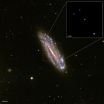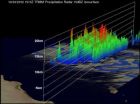(Press-News.org) One of the lowest mass supermassive black holes ever observed in the middle of a galaxy has been identified, thanks to NASA's Chandra X-ray Observatory and several other observatories. The host galaxy is of a type not expected to harbor supermassive black holes, suggesting that this black hole, while related to its supermassive cousins, may have a different origin.
The black hole is located in the middle of the spiral galaxy NGC 4178, shown in this image from the Sloan Digital Sky Survey. The inset shows an X-ray source at the position of the black hole, in the center of a Chandra image. An analysis of the Chandra data, along with infrared data from NASA's Spitzer Space Telescope and radio data from the NSF's Very Large Array suggests that the black hole is near the extreme low-mass end of the supermassive black hole range.
These results were published in the July 1, 2012 issue of The Astrophysical Journal by Nathan Secrest, from George Mason University in Fairfax, Virginia, and collaborators.
The properties of the X-ray source, including its brightness and spectrum - the amount of X-rays at different wavelengths - and its brightness at infrared wavelengths, suggest that a black hole in the center of NGC 4178 is rapidly pulling in material from its surroundings. The same data also suggest that light generated by this infalling material is heavily absorbed by gas and dust surrounding the black hole.
A known relationship between the mass of a black hole and the amount of X-rays and radio waves it generates was used to estimate the mass of the black hole. This method gives a black hole mass estimate of less than about 200,000 times that of the sun. This agrees with mass estimates from several other methods employed by the authors, and is lower than the typical values for supermassive black holes of millions to billions of times the mass of the sun.
NGC 4178 is a spiral galaxy located about 55 million light years from Earth. It does not contain a bright central concentration, or bulge, of stars in its center. Besides NGC 4178, four other galaxies without bulges are currently thought to contain supermassive black holes. Of these four black holes, two have masses that may be close to that of the black hole in NGC 4178. XMM-Newton observations of an X-ray source discovered by Chandra in the center of the galaxy NGC 4561 indicate that the mass of this black hole is greater than 20,000 times the mass of the sun, but the mass could be substantially higher if the black hole is pulling in material slowly, causing it to generate less X-ray emission. A paper describing these results was published in the October 1st, 2012 issue of The Astrophysical Journal by Araya Salvo and collaborators.
The mass of the black hole in the galaxy NGC 4395 is estimated to be about 360,000 times the mass of the sun, as published by Peterson and collaborators in the October 20, 2005 issue of the Astrophysical Journal.
Previously, astronomers have found that observations of a large number of galaxies are consistent with a close correlation between the mass of a supermassive black hole and the mass of the bulge of its host galaxy. Theoretical models developed to explain these results invoke mergers of galaxies, and predict that galaxies without bulges are unlikely to host supermassive black holes. The results found for NGC 4178 and the four other galaxies mentioned run counter to these predictions, and may suggest that more than one mechanism is at work in forming supermassive black holes.
Three other X-ray sources were found in the Chandra image. If they are located in NGC 4178 they are likely to be binary systems containing a black hole or neutron star. The brightest of the three sources may be an intermediate-mass black hole with a mass that is about 6,000 times that of the sun.
The paper may be found at: http://arxiv.org/abs/1205.0230.
INFORMATION:
The co-authors of the paper describing these results are Shobita Satyapal, and Mario Gliozzi, from George Mason University; Teddy Cheung, from the National Academy of Science in Washington DC; Anil Seth, from the University of Utah in Salt Lake City, UT, and Torsten Boeker from ESA/ESTEC in the Netherlands.
NASA's Marshall Space Flight Center in Huntsville, Ala., manages the Chandra program for NASA's Science Mission Directorate in Washington. The Smithsonian Astrophysical Observatory controls Chandra's science and flight operations from Cambridge, Mass.
Revealing a mini-supermassive black hole
2012-10-25
ELSE PRESS RELEASES FROM THIS DATE:
NASA's TRMM satellite sees birth of Arabian Sea cyclone
2012-10-25
NASA's TRMM satellite measured rainfall and towering clouds within the Arabian Sea's first tropical cyclone of the season as it passed overhead from space. Meanwhile, the infrared AIRS instrument aboard NASA's Aqua satellite noticed that strong thunderstorms surrounded the center of the storm. Tropical Cyclone 1A is expected to be short-lived as it heads for a landfall in Somalia on Oct. 25.
Since it was launched in 1997 the Tropical Rainfall Measuring Mission (TRMM) satellite has been useful for monitoring tropical cyclones in the tropics. TRMM passed above the first ...
Moderate drinking decreases number of new brain cells
2012-10-25
Drinking a couple of glasses of wine each day has generally been considered a good way to promote cardiovascular and brain health. But a new Rutgers University study indicates that there is a fine line between moderate and binge drinking – a risky behavior that can decrease the making of adult brain cells by as much as 40 percent.
In a study posted online in the journal Neuroscience, scheduled to be published on November 8, lead author Megan Anderson, a graduate student working with Dr. Tracey J. Shors, Professor II in Behavioral and Systems Neuroscience in the Department ...
Study shows whites twice as likely as blacks to get CPR from bystanders
2012-10-25
AURORA, Colo. (Oct. 24, 2012) – In the first study of its kind, researchers have found that those who suffer cardiac arrests in upper income, white neighborhoods are nearly twice as likely to get cardiopulmonary resuscitation (CPR) than people who collapse in low-income, black neighborhoods.
"If you drop in a neighborhood that is 80 percent white with a median income over $40,000 a year, you have a 55 percent chance of getting CPR," said study author Comilla Sasson, MD, an emergency room physician at the University of Colorado Hospital. "If you drop in a poor, black neighborhood ...
Reclaiming rare earths
2012-10-25
Recycling keeps paper, plastics, and even jeans out of landfills. Could recycling rare-earth magnets do the same? Perhaps, if the recycling process can be improved.
Scientists at the U.S. Department of Energy's (DOE) Ames Laboratory are working to more effectively remove the neodymium, a rare earth element, from the mix of other materials in a magnet. Initial results show recycled materials maintain the properties that make rare-earth magnets useful.
The current rare earth recycling research builds on Ames Laboratory's decades of rare-earth processing experience. In ...
Sleep-deprived bees have difficulty relearning
2012-10-25
Everyone feels refreshed after a good night's sleep, but sleep does more than just rejuvenate, it can also consolidate memories. 'The rapid eye movement form of sleep and slow wave sleep are involved in cognitive forms of memory such as learning motor skills and consciously accessible memory', explains Randolf Menzel from the Freie Universtät Berlin, Germany. According to Menzel, the concept that something during sleep reactivates a memory for consolidation is a basic theory in sleep research. However, the human brain is far too complex to begin dissecting the intricate ...
Experts call for increased neonatal inclusion in pediatric drug trials
2012-10-25
Cincinnati, OH, October 25, 2012 -- Clinical drug trials are a vital part of pharmaceutical manufacturers gaining approval for use by the U.S. Food and Drug Administration. A Commentary scheduled for publication in The Journal of Pediatrics assesses the issues surrounding the lack of clinical trials on medications used by children, most notably neonates, and how drug manufacturers and academic researchers could work together to create clinical trials that would benefit this underrepresented population.
Henry Akinibi, MD, and colleagues from Cincinnati Children's Hospital ...
When she says, 'It's not you, it's me,' it really might be you, UCLA study suggests
2012-10-25
Long after women have chosen Mr. Stable over Mr. Sexy, they struggle unconsciously with the decision, according to a new study by UCLA researchers who look at subtle changes in behavior during ovulation.
At their most fertile period, these women are less likely to feel close to their mates and more likely to find fault with them than women mated to more sexually desirable men, the research shows.
"A woman evaluates her relationship differently at different times in her cycle, and her evaluation seems to be colored by how sexually attractive she perceives her partner ...
Journal of Public Health Management and Practice now available on the iPad
2012-10-25
Philadelphia PA (October 25, 2012) – The Journal of Public Health Management and Practice, the premier source of practice-based information for public health management expert, announced today the availability of the journal on the iPad to be launched with a special November/December issue focused on public health services and systems research. The Journal of Public Health Management and Practice, (JPHMP) is published in print, online and digitally by Lippincott Williams & Wilkins, a part of Wolters Kluwer Health.
"In today's increasingly digital environment, offering ...
Moffitt researchers identify unique immune gene signature across thousands of patients' solid tumors
2012-10-25
Researchers at Moffitt Cancer Center have discovered a unique immune gene signature that can predict the presence of microscopic lymph node-like structures in metastatic melanoma. The presence of these immune structures, the researchers said, appears to be associated with better survival and may indicate the possibility of selecting patients for immunotherapy based solely on the immune-related makeup of their tumors as an approach to personalized medicine.
The study appears in Scientific Reports, a journal from Nature Publishing Group.
In this study, the researchers ...
Study Finds Weekend Patients at Greater Risk of Negative Outcomes
2012-10-25
Having a stroke, being in a car accident, experiencing a heart attack -- these are experiences that no one can determine when they will happen. A new study, however, suggests that whether such incidents happen on a weekday or a weekend may have an impact on a hospital patient's likelihood of survival. This is known as the "weekend effect" and should be a concern for both hospitals and patients alike.
Study Examines the Weekend Effect
The study, performed by researchers at Johns Hopkins University School of Medicine and published in the Journal of Surgical ...


